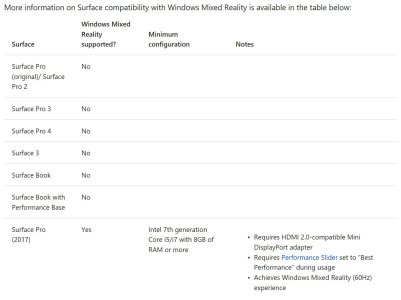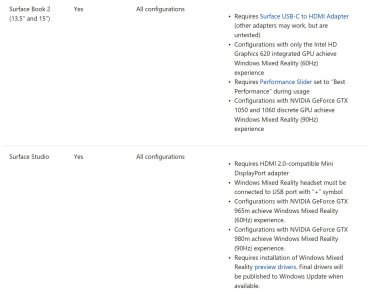bill_correa
New member
- Dec 30, 2017
- 3
- 0
- 0
BEWARE: After reading reviews and comparisons, I chose the HP Windows Mixed Reality Headset - mainly because of the durability reviews of heavier materials. It felt very comfortable and solid... although in the flipped up position, it made my head feel off balance (similar sensation to pee-wee football helmet).
Mine arrived before Christmas, after which the entire setup experience was met with great disappointment. For my use case scenario, it just went back into the box for return… and the reason is quite baffling! According to HP support website, the HP Windows Mixed Reality Headset must be connected directly to the computer to display video.
Maybe doesn’t seem unreasonable for performance reasons, until you realize that it’s a full size HDMI port along with powered USB 3.0. If you have HDMI full size output on your system, and you meet all the other spec requirements, then you should be fine. But for the other 80% of systems out there, something other than HDMI out is going to be a problem. I had the USB 3 no problem on my mid-level Surface Studio (i7/16GB/2GB GPU), but alas I have a Mini DisplayPort for out video. I also have a top of the line Surface Book, and an HP Workstation with a full size display port for HD out video. In all cases, using a Mini DisplayPort or DisplayPort to HDMI adapter (yes a high-end one that supports 4k/60Hz)… results = no video!
I actually started with a cheaper video dongle and the system check didn't detect video in setup, so I upgraded to the 4K dongle which setup then detected and completed showing the unit was online and working - but without actually showing any video signal. I went as far as to setup Steam with the Windows Mixed Reality add-in so that is shows a viewer on regular display of what is supposed be getting sent to the headset. After searching on HP support site, their troubleshooting guidance states that USB and HDMI must be connected DIRECTLY to the computer - no dongles, USB hubs, etc. I also found a post from 8/15/17 sharing same experience specific to Surface Studio and Surface Book... essentially zero support for Mini DisplayPort or any other connection other than direct HDMI and powered USB 3.0 connections.
I have since confirmed with a colleague who purchased the Samsung Odyssey Windows Mixed Reality Headset and it works just fine with a Mini DisplayPort to HDMI adapter – he has it plugged into his Surface Dock and uses a Surface Book 2 without issue.
Mine arrived before Christmas, after which the entire setup experience was met with great disappointment. For my use case scenario, it just went back into the box for return… and the reason is quite baffling! According to HP support website, the HP Windows Mixed Reality Headset must be connected directly to the computer to display video.
Maybe doesn’t seem unreasonable for performance reasons, until you realize that it’s a full size HDMI port along with powered USB 3.0. If you have HDMI full size output on your system, and you meet all the other spec requirements, then you should be fine. But for the other 80% of systems out there, something other than HDMI out is going to be a problem. I had the USB 3 no problem on my mid-level Surface Studio (i7/16GB/2GB GPU), but alas I have a Mini DisplayPort for out video. I also have a top of the line Surface Book, and an HP Workstation with a full size display port for HD out video. In all cases, using a Mini DisplayPort or DisplayPort to HDMI adapter (yes a high-end one that supports 4k/60Hz)… results = no video!
I actually started with a cheaper video dongle and the system check didn't detect video in setup, so I upgraded to the 4K dongle which setup then detected and completed showing the unit was online and working - but without actually showing any video signal. I went as far as to setup Steam with the Windows Mixed Reality add-in so that is shows a viewer on regular display of what is supposed be getting sent to the headset. After searching on HP support site, their troubleshooting guidance states that USB and HDMI must be connected DIRECTLY to the computer - no dongles, USB hubs, etc. I also found a post from 8/15/17 sharing same experience specific to Surface Studio and Surface Book... essentially zero support for Mini DisplayPort or any other connection other than direct HDMI and powered USB 3.0 connections.
I have since confirmed with a colleague who purchased the Samsung Odyssey Windows Mixed Reality Headset and it works just fine with a Mini DisplayPort to HDMI adapter – he has it plugged into his Surface Dock and uses a Surface Book 2 without issue.



